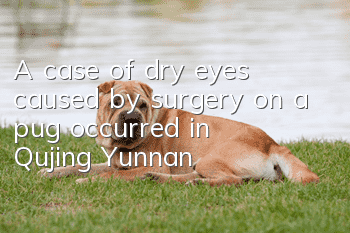A case of dry eyes caused by surgery on a pug occurred in Qujing, Yunnan!

A 3-year-old Bull Chou Chou child had a third eyelid hyperplasia surgery on both eyes two years ago. Recently, the owner noticed an increase in secretions from both eyes. He came to see a doctor and found out that he had severe dry eyes. Ugly children will have to rely on artificial tears for their remaining years - Dr. Jiang Tao from Qujing, Yunnan
The surface of the dog's eyeballs is continuously protected by a film formed by tears, which has a moistening effect and helps heal eye injuries and prevent eye infections. Like a "hydrating mask" on the skin, it locks in moisture, keeps it moisturized, and blocks invasion. The tears that moisturize the eye surface are secreted by the lacrimal glands, and the outer layer of the tear film that "locks in water" is mainly composed of lipids secreted by the meibomian glands. Without this layer of lipids, tears evaporate quickly and the eyes become dry. When the quality and quantity of this layer of tears are abnormal, the tear film will be damaged, causing eye discomfort or visual dysfunction, such as dry eyes, photophobia and wind fear, redness and itching, heavy eyelids, excessive secretions, and blurred vision. , foreign body sensation, unknown tears...
Dry eye disease in dogs has been proven to be the basis of stubborn tear gland degeneration and inflammation, which cannot be completely cured. So what are the causes of dry eye disease in dogs? The editor will tell you that only by finding the root cause can it be effectively prevented.
1. Caused by drugs: Sulfonium drugs (some commonly used eye drops) can cause dry eye in dogs.
2. Caused by surgery: Dry eye syndrome is caused by surgical removal of the prolapsed third eyelid gland (cherry eye).
3. Spontaneous and senile causes: The cause of dry eye in dogs is related to the gradual atrophy of lacrimal glands in animals as they age.
4. Caused by autoimmunity: Up to 30% of dry eye syndrome is caused spontaneously, which is related to the destruction of the lacrimal gland and third eyelid gland by autoimmunity. Among dry eye cases at the Ophthalmology Clinic of the National Taiwan University Animal Hospital, a significantly higher proportion of patients had abnormal immune conditions, including allergies or trichocystis infections.
5. Caused by trauma to the eye socket or under the eye socket: The tear gland and third eyelid gland are injured due to trauma, or the nerves in charge of the lacrimal gland and third eyelid gland are damaged, causing abnormal tear secretion.
6. Caused by canine distemper: Canine distemper virus can affect the lacrimal glands and third eyelid glands, resulting in temporary or permanent loss of tear secretion function.
7. Congenital or genetic causes: Congenital acinar hypoplasia often occurs in young or young adult dogs of miniature breeds, such as Chihuahuas and Yorkshire terriers. In addition, there are dog breeds that are genetically prone to dry eye disease (but the age of onset is not necessarily the same). This is often related to autoimmune attacks on the tear glands. Dog breeds include Maltese, Yorkshire Terrier, and Shih Tzu (details) , Pug, Pekingese, Boston Terrier, West Highland Terrier, King Charles Spaniel, Lhasa Apso, English Cocker Spaniel,American Cocker Spaniel and British Bulldog, etc.
8. Caused by the lack of distribution of sensory nerves on the surface of the eyeball (craninal nerve V).
9. Caused by the lack of distribution of parasympathetic sensory nerves in the lacrimal gland (craninal nerve VII).
10. Other causes: There are many unproven or unknown factors that have been proposed.
- Why don’t dogs like having their paws touched?
- Why is the dog vomiting white foam?
- How to train Shiba Inu puppies? Daily training methods for Shiba Inu puppies!
- How to tell when dogs are constipated? Some common factors that cause dog constipation!
- What to do if your dog is hit by a car
- How do I discipline Alaska’s dog who loves to bite?
- St. Bernard dog gastroenteritis symptoms and treatments
- How to choose Samoyed? Samoyed buying tips!
- When your dog has these abnormal conditions, don’t you pay attention?
- What should novices pay attention to when buying a pet dog? These tips can help you!



